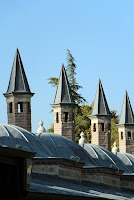IT'S official, I'm perfect.
I had long suspected as much, but it was confirmed today when I visited the Mevlana Museum in the Turkish city of Konya.
There's a sign above the front door explaining "those who enter here incomplete will come out perfect" and after walking through the grand Ottoman doors, and exiting the historic building some time later, I felt elevated to a new level of perfection.
A fellow called Rumi - or Mevlana to his mates - was one of the 13th century's most respected philosophers and when he died in the 1200s his ancestors developed the technique of falling into a trance and spinning for hours to pay their respect.
There were hundreds of Whirling Dervishes lodges around Turkey in the decades after Rumi's death, with the order considered to be just another religious sect, but all were abolished by Ataturk when he reorganised Turkish society in the early days of independence.
The Konya lodge survived and was reestablished in 1957, because it was "a cultural association intended to preserve a historic tradition", and while tourists are treated to Whirling Dervish displays in different parts of the country they can visit the Mevlana Museum to see where it all began and gaze across rows of graves that sit below the buildings lofty domes.
The old mosque is topped by a turquoise tower that's considered to be one of the most distinctive sites in Turkey, and I spoke to a museum guide who told me that when the ornate crown was put in place the tiles were a dark blue but had faded to the softer shade over the centuries.
- posted from my iPad
Location:Koza Sk,Kaş,Turkey












